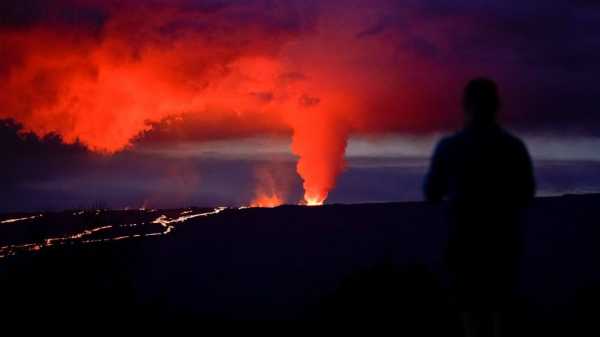
KAILUA-KONA, Hawaii — The world's largest volcano oozed rivers of glowing lava Wednesday, drawing thousands of awestruck viewers who jammed a Hawaii highway that could soon be covered by the flow.
Mauna Loa awoke from its 38-year slumber Sunday, causing volcanic ash and debris to drift down from the sky. A main highway linking towns on the east and west coasts of the Big Island became an impromptu viewing point, with thousands of cars jamming the highway near Volcanoes National Park.
Anne Andersen left her overnight shift as a nurse to see the spectacle Wednesday, afraid that the road would soon be closed.
“It's Mother Nature showing us her face,” she said, as the volcano belched gas on the horizon. “It's pretty exciting."
Gordon Brown, a visitor from Loomis, California, could see the bright orange lava from the bedroom of his rental house. So he headed out for a close-up view with his wife.
“We just wanted … to come see this as close as we could get. And it is so bright, it just blows my mind,” Brown said.
The lava was tumbling slowly down the slope and was about 6 miles (10 kilometers) from the highway known as Saddle Road. It was not clear when, or if, it would cover the road, which runs through old lava flows.
The road bisects the island and connects the cities of Hilo and Kailua-Kona. People traveling between them would need to take a longer coastal road if Saddle Road becomes impassable, adding several hours of drive time.
Ken Hon, scientist in charge at the Hawaiian Volcano Observatory, said at current rate of flow, the soonest the lava would get to the road is two days, but he added that things could change.
Mauna Loa last erupted in 1984. The current eruption is its 34th since written record keeping began in 1843. Its smaller neighbor, Kilauea, has been erupting since September 2021, so visitors to the national park were being treated to the rare sight of two simultaneous eruptive events: the glow from Kilauea’s lava lake and lava from a Mauna Loa fissure.
Abel Brown, a visitor from Las Vegas, was impressed by the natural forces on display. He planned to take a close-up helicopter tour later in the day — but not too close.
“There's a lot of fear and trepidation if you get really close to it,” Brown said. “The closer you get, the more powerful it is and the more scary it is.”
Officials were initially concerned that lava flowing down Mauna Loa would head toward the community of South Kona, but scientists later assured the public the eruption had migrated to a rift zone on the volcano's northeast flank and wasn’t threatening communities.
The smell of volcanic gases and sulfur was thick along Saddle Road, where people watched the wide stream of lava creep closer. Clouds cleared to reveal a large plume of gas and ash rising from a vent on the mountain.
Gov. David Ige issued an emergency proclamation to allow responders to arrive quickly or limit access as needed.
Lava crossed the Mauna Loa Observatory access road Monday night and cut off power to the facility, Hon said. It could move toward the county seat of Hilo, he added, but that could take a week or longer.
Meanwhile, scientists are trying to measure the gas emitted from the eruption.
“It's just very early in this eruption right now,” Hon said.
———
Kelleher reported from Honolulu. Associated Press reporters Jennifer Sinco Kelleher and Audrey McAvoy in Honolulu and Greg Bull and Haven Daley in Hilo contributed to this report.
Sourse: abcnews.go.com





